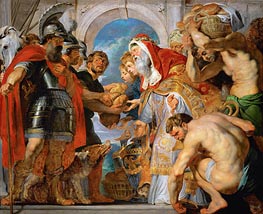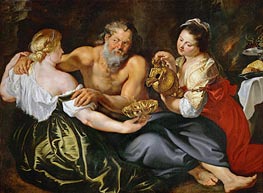Bathsheba at the Fountain, c.1635 by Peter Paul Rubens
Canvas Print - 13771-RPP
Location: Gemaldegalerie Alte Meister, Dresden, GermanyOriginal Size: 175 x 126 cm
Giclée Canvas Print | $59.41 USD
Your Selection
Customize Your Print
By using the red up or down arrows, you have the option to proportionally increase or decrease the printed area in inches as per your preference.
*Max printing size: 41.3 x 29.9 in
*Max framing size: Long side up to 28"
"Bathsheba at the Fountain" will be custom-printed for your order using the latest giclée printing technology. This technique ensures that the Canvas Print captures an exceptional level of detail, showcasing vibrant and vivid colors with remarkable clarity.
Our use of the finest quality, fine-textured canvas lends art reproductions a painting-like appearance. Combined with a satin-gloss coating, it delivers exceptional print outcomes, showcasing vivid colors, intricate details, deep blacks, and impeccable contrasts. The canvas structure is also highly compatible with canvas stretching frames, further enhancing its versatility.
To ensure proper stretching of the artwork on the stretcher-bar, we add additional blank borders around the printed area on all sides.
Our printing process utilizes cutting-edge technology and employs the Giclée printmaking method, ensuring exceptional quality. The colors undergo independent verification, guaranteeing a lifespan of over 100 years.
Please note that there are postal restrictions limiting the size of framed prints to a maximum of 28 inches along the longest side of the painting. If you desire a larger art print, we recommend utilizing the services of your local framing studio.
*It is important to mention that the framing option is unavailable for certain paintings, such as those with oval or round shapes.
If you select a frameless art print of "Bathsheba at the Fountain" by Rubens, it will be prepared for shipment within 48 hours. However, if you prefer a framed artwork, the printing and framing process will typically require approximately 7-8 days before it is ready to be shipped.
We provide complimentary delivery for up to two unframed (rolled-up) art prints in a single order. Our standard delivery is free and typically takes 10-14 working days to arrive.
For faster shipping, we also offer express DHL shipping, which usually takes 2-4 working days. The cost of express shipping is determined by the weight and volume of the shipment, as well as the delivery destination.
Once you have added the paintings to your shopping cart, you can use the "Shipping estimates" tool to obtain information about available transport services and their respective prices.
All unframed art prints are delivered rolled up in secure postal tubes, ensuring their protection during transportation. Framed art prints, on the other hand, are shipped in cardboard packaging with additional corner protectors for added safety.
Painting Information
One of the paintings for which Helene Fourment posed for the artist - without his having sought an exact portrait likeness - is "Bathsheba" in the Dresden Gallery. The story of Bathsheba is told in the Book of Samuel in the Old Testament. King David saw from the roof of his palace "a woman washing herself, and the woman was very beautiful." David learned that it was Bathsheba, the wife of his captain Uriah, and "sent men to bring her. And when she came in to him, he slept with her... The woman became pregnant and caused David to be notified." In order to get rid of the husband, the king sent Uriah to certain death, ordering him to take a letter to Joab the governor alone. Then he married Bathsheba, and she bore him a son, whom she named Solomon. A grim story full of sinful perversions! This is how the Dutchman Rembrandt, who elaborated on this subject several times, interpreted it in the painting he painted in 1654, now in the Louvre. There, Bathsheba is depicted quite naked; her body stands out from the vague darkness of the background, "of which the painting itself seems to be a praise, and which yet deep down the woman questions fatefully". Rembrandt, the insightful interpreter of mental processes, glimpses the "loneliness of the doubts and conflicting feelings casting a shadow in this woman's soul". The Flemish Rubens's Bathsheba, on the other hand, knows neither doubts nor contradictory feelings - she is aware of her beauty and revels in the seductive power of her body. Thus the artist's life-affirming optimism shows only the bright sides of the legend, the happily exhilarating image of Bathsheba-Helene, in whose face only love and devotion are reflected. Rubens was indeed not the first to devote himself to the glorification of woman - let us think only of the Venetian masters of the Renaissance - but none before him, and few since him, have attempted or succeeded in portraying woman so convincingly with the radiance of her sensuous beauty.
The colours shine as if from within: the red of the tablecloth and curtain, the rich brown of the skin, the greenish blue of the negro page's dress, whose swarthiness brings out even more the richly tinted tonality of the nude central figure. It is indicative of the master's late style that the increasingly imposing pictorial concept led to a freer construction of the composition and the figures.





















